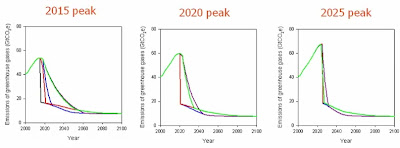28 Dec Climate Change Threatens Civilization (part 1)
I've been avidly following David Roberts' gold-standard blogging for several months now. Roberts is brilliant, but that's just one reason his recent series on the brutal truth about climate change got my attention. Written during the COP17 talks earlier this month, this series has Roberts at knife's edge.
I too have freaked out at the hopelessness of climate change, focusing my life on a variety of environmental efforts too numerous to list for several years now. Interestingly, Roberts' thesis has something in common with my favorite economist, Gernot Wagner. Independently of each other they seem to be saying the same thing: we're not going to make it.
Wagner's thoughts, as expressed in his excellent new book, are grounded in three principals: 1. the analogy of the 10 foot woman, 2. we're not responding appropriately to climate change (himself included), 3. we're playing "planetary Russian roulette." The 10 foot woman analogy is used to illustrate that in Economics radical, random, incredible events occur quite often and that such events forecast systemic breakdown. The same can be said about the earth's climate. Incredible things are happening. (Note that protecting our economies is a popular priority and regulators are at least working on that problem, climate not so much.) Wagner's book goes on to explore the changes that need to take place, at what scale, and who needs to enact such changes in order to make a difference on climate concerns.
According to Roberts the latest science confirms we're on an emissions trajectory that will increase the Earth's average annual temperature by at least 4°Celsius this century. Wagner's 10 foot woman analogy suggests things are potentially far worse than any one is willing to discuss, he even cites a renown Harvard economist (paper here) who believes we have a 5% statistical chance of seeing an increase of 12°C this century. The International Energy Association thinks we're on course for 6°C this century. Meanwhile, the InterGovernmental Panel on Climate Change and 141 nations agree — 2°C is the maximum warming we can allow this century. In the last three decades, global temps have risen 0.6°C.1
With all that in mind, here are summary points from Roberts "Brutal Logic of Climate Change" piece, part one of a five part series:
I. Reframing won't work. Because climate change is a political buzz kill, climate activists everywhere are trying to reframe the conversation. "This can't work. At least it cannot work if we hope to avoid terrible consequences." Today's climate problems require war/crisis-like responsiveness, now. Without critical mass, such responsiveness is impossible.
II. How urgent is climate change responsiveness? "The Copenhagen Accord, signed by 141 countries (including the U.S.) and representing over 87 percent of global CO2 emissions, explicitly recognizes the scientific view that the world's economies must limit the increase in global temperature to below 2 degrees Celsius." However, scientists now believe a 2°C increase in average annual surface temps around the globe will cause extreme damage to our ecosystems and way of life. They also believe we're headed for a 4° to 10°C increase, "which we know to be a potentially civilization-threatening disaster." (4° to 10°C = 7.2° to 18°F)
III. We're accelerating in the wrong direction. "Between 2000 and 2007, emissions rose at around 3.5 percent a year; in 2009 emissions were up 5.6 percent. In 2010, we hit 5.9 percent growth, a record. We aren't just going in the wrong direction — we're accelerating in the wrong direction."
IV. This ain't gonna be easy. "Any carbon reduction pathway that limits temperature rise to 2 degrees C shows global emissions peaking extremely soon and declining extremely quickly. {See graphic below} If we delay the global emissions peak until 2025, we pretty much have to drop off a cliff afterwards to avoid 2 degrees C. Short of a meteor strike that shuts down industrial civilization, that's unlikely… A key fact to remember: For a given carbon reduction pathway, the later emissions peak, the faster they have to fall to stay under budget."
Click to enlarge.
V. We need a Carbon Budget. The only way for "the rich, industrialized countries of the world" to peak emissions in 2015 and decline their emissions 10 percent year-on-year after that for the rest of the century — or to meet any goals that might limit warming to 2°C is to determine a global carbon budget and divvy it up among countries.
VI. Can't we just do 4°C? [7.2°F] "It might seem that, given the extraordinary difficulty of hitting 2 degrees C, we ought to lower our sights a bit and accept that we're going to hit 4 degrees C. It won't be ideal, but hitting anything lower than that is just too difficult and expensive. To hit 4 degrees C we would "only" have to peak global emissions in 2020 and decline thereafter at the relatively leisurely rate (ha ha) of around 3.5 percent per year. Sadly, even that cold comfort is not available to us. The thing is, if 2 degrees C is extremely dangerous, 4 degrees C is absolutely catastrophic. In fact, according Kevin Anderson (who's summaries are linked above as latest science), "a 4 degrees C future is incompatible with an organized global community, is likely to be beyond 'adaptation', is devastating to the majority of ecosystems, and has a high probability of not being stable.""
Is environmental realism the new environmentalism?
###
Four more parts in this series: coming soon.
Visit my blog for additional stuff.
Footnote
(1): via America's Climate Choices. The National Academies Press. 2011. p. 15. "The average temperature of the Earth’s surface increased by about 1.4 °F (0.8 °C) over the past 100 years, with about 1.0 °F (0.6 °C) of this warming occurring over just the past three decades"



No Comments